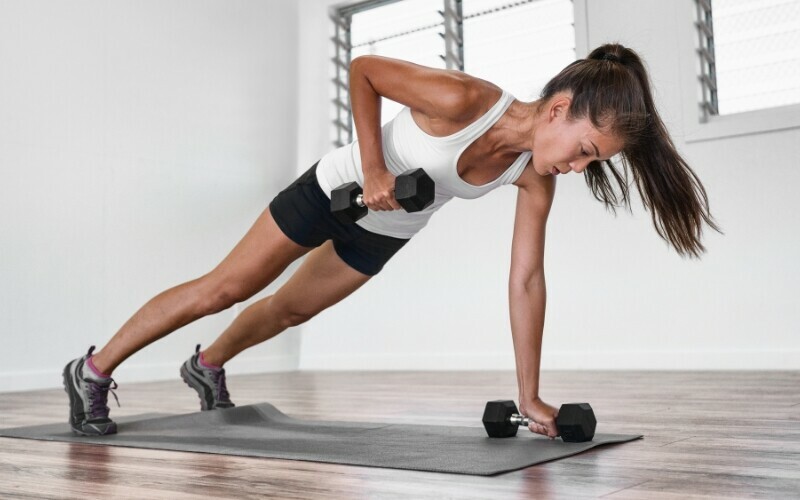Lifting weights after 50 can offer numerous health benefits. Let’s look at some key strategies for women embracing health and vitality as they age. In this Strength Training Guide for Women Over 50 we will focus on safe, effective ways to help build strength, improve bone density, and enhance overall well-being.
In fact, we have listed 8 reasons you should do resistance training. Whether you’re a beginner or looking to revamp your routine, this guide will empower you to stay strong, healthy, and confident in your fitness journey.
Included below is a Sample weekly strength routine, and some safety tips to prevent injury while exercising.
The Benefits of Lifting Weights After 50
One major benefit of weight lifting is maintaining muscle mass.
After the age of 30 we gradually lose muscle mass. Over time, this can lead to frailty and a higher risk of falls. Strength training effectively counters this by building and preserving muscle, and helps you stay active and independent.
For women, strength training isn’t about getting bulky muscles — however, it is, a fantastic way to boost overall health and stay strong.
Perhaps you hesitate to try weight-training. It is possible that you heard common myths and misconceptions floating around. But believe me, the benefits of strength training are huge whether you’re a fitness newbie or have been at it for years.
Benefits of strength training for women
A-One major benefit of resistance training is maintaining muscle mass. Strength training effectively counters muscle loss. As you age, this muscle loss is sometimes called, “sarcopenia.” However, if your muscles are strong, you can remain active and independent.
B-Bone health is another biggie. Weight-bearing exercises like lifting can increase bone density, reducing the risk of osteoporosis and fractures. Strong bones are key to overall stability and mobility, improving posture, and making daily activities easier and safer.
C-Cardiovascular health also gets a boost. Improved muscle mass leads to better circulation and heart health.
D-Plus, regular strength workouts can help manage conditions like arthritis and diabetes, making them more bearable. Stronger muscles takes the pressure off your joints, giving you less pain.
Plus, we all love the feeling of being strong and capable.
Strength training is not just for the guys!
One concern some women may have about strength training is the intimidation factor. Strength training is for everyone, not just guys!
More and more women are comfortable working out in the gym, and you’re just as entitled to that space as anyone!
Another great option—plenty of effective workouts at home concentrate on strength training for women over 50, and they can be done with minimal equipment.
Proper Form and Technique
Some women worry about the risk of injury. Focus on proper form and start with manageable weights.
Over time, as your strength and confidence grow, you can increase the intensity.
And if you’re unsure about your technique, consult with a trainer, even just a few sessions, can make all the difference.
The Ultimate Fitness Journal for Tracking Your Gym Goals
Detailed Workout Planner & Log Book For Men and Women
Signature Fitness Neoprene Dumbbell Hand Weights
Anti-Slip, Anti-roll, Hex Shape Colorful, Pair or Set with Stand
Build Muscles in Only 10 Minutes a Day with a Cellerciser®

This post contains affiliate links. If you click on and purchase through one of those links, you won’t pay a penny more, but we’ll get a small commission, which helps keep our website operating. Thanks! As an Amazon Associate, I earn from qualifying purchases.

4-Debunking myths about women and weightlifting
Some people fear that lifting weights will make women bulky.
In reality, it is difficult for women’s bodies to gain large amounts of muscle mass without a specific and intense regimen.
Instead, you’ll likely notice leaner muscles and increased definition. So, no need to worry about turning into the Hulk!
Strength training is not about being perfect; it’s about trying something that will make you feel fantastic, inside and out.
8 Reasons You Should Do Resistance Training.
Is strength training good for women’s health? Absolutely! Strength training offers a myriad of health benefits for women. Strength training is a fantastic activity that benefits nearly every aspect of your well-being.
1-Build Lean Muscle Mass
Lifting weights helps build lean muscle and improve muscle tone. After 30, muscle mass naturally declines. Strength training helps combat this loss.
And strength training isn’t just about building muscle.
2-Heart Health
Regular strength training can lower blood pressure and improve cardiovascular health.
3-Increased Bone Density
Strength training can lead to increased bone density. Weight-bearing exercises help strengthen your bones, reducing the risk of osteoporosis.
4-Feel-Good Hormones Reduce Stress
But that’s just scratching the surface. Exercise, including strength training, releases endorphins, those feel-good hormones that lift your mood and reduce anxiety. Feeling stronger can also lead to improved self-esteem and confidence. Who doesn’t want that?
5-Impact on metabolism and weight management
Lifting weights increases resting metabolic rate, helping with weight management. More muscle mass means your body burns more calories, even when you’re just chilling on the couch. That’s a win in my book.
Strength training can also help regulate insulin and lower the risk of type 2 diabetes.
6-Strength training and menopause
It can also relieve some symptoms of menopause, offering a more balanced and comfortable experience during those years
7-Enhanced Functional Strength:
Strength training enhances stability, reducing the risk of falls. It can improve flexibility, especially when combined with stretching. Everyday tasks become easier as strength increases, improving overall quality of life.
8-Sense of Community
Lastly, but equally important, is the sense of community and support you can find. Whether it’s through a group class or an online community, connecting with others who share a common goal can be incredibly motivating and make the whole experience more enjoyable. Plus, it’s always nice to have a cheer squad!

How Many Days a Week Should a Woman Strength Train?
For women around 50, the frequency of strength training sessions can vary based on fitness level and goals.
Generally, two to three times a week is a good target. Aim for two or three non-consecutive days of strength training each week.
Allow at least 48 hours of muscle recovery and growth between sessions when you are targeting the same muscle group. This schedule allows enough time for muscles to repair themselves between sessions while still offering consistent benefits.
Each session doesn’t have to be long—even 30 to 45 minutes can be effective if your workout includes multiple muscle groups.
Modifying workouts for different fitness levels
It’s essential to modify workouts based on your fitness level.
Heavy lifting might not be suitable for everyone, and that’s perfectly fine. Using lighter weights with higher repetitions or incorporating resistance bands can be equally effective while minimizing the risk of injury.
How to Start Strength Training as a Woman?
Many women may want to begin by just doing body-weight exercises. Push-ups, planks, bird-dogs, and squats are a good place to start. Then you can work your way up to using weights.
Be consistent, keep it simple, and stay safe and you will effectively and efficiently improve strength and build muscle.
The 5 basic weight-training exercises that will make you fit and strong are:
- Squat – How to do squats properly for beginners? Your feet should be slightly wider than hip-width apart. Your toes should be slightly pointing outward. Flex your stomach, squeeze your glutes, inhale deeply into your stomach. Move your butt back, squat down slowly.
- Hip-hinge – Stand with your feet shoulder-width apart. Shift your weight to your heels. With your chest open, back flat, and knees slightly bent, push your hips back as you hinge your torso forward
- Overhead press – Beginners should pick a lighter weight to start, slowly increasing the weight that they can lift for 10 repetitions (a person should feel fatigued at the final rep). Women might start with 5-pound dumbbells and men with 10-pound dumbbells.
- Chest press – Not only will your posture improve from working the chest, but these exercises will also make daily functions a lot easier.
- Row – Is rowing good for 50 year old woman? Indoor rowing is one of the few ways of providing a comprehensive yet low-impact workout.
Working with a trainer can be incredibly beneficial,
especially when you’re starting out. They can guide you on proper form and technique, ensuring you’re lifting safely and effectively.
Preventing and managing pre-existing health issues
Working with a trainer can also help tailor a program specifically for your needs, taking into account any pre-existing conditions or limitations.
Strength training after 50 isn’t just doable—it’s rewarding. The key is to listen to your body, start slow, and be consistent. The positive changes, both physically and mentally, will make it all worthwhile.
Create a Personalized Strength Training Routine
Kick-starting a strength training routine may seem daunting at first, but with the right approach, it’s a breeze.
1-Assessing your current fitness level
Start with assessing your current fitness level. Knowing where you’re at will help you set realistic and achievable goals. Are you just starting out or looking to level up an existing routine?
2-Setting realistic and achievable goals
Setting clear goals is key. They help you stay focused and motivated.
- Do you want to feel stronger?
- Improve your posture?
- Maybe shed a few pounds?
All valid goals. Write them down and track your progress. It’s super satisfying to see how far you’ve come.
3-Choosing the right exercises and equipment
Choose the right exercise is important, too. Compound movements like squats, dead lifts, and bench presses are great because they work multiple muscle groups at once.
But don’t shy away from isolation exercises like bicep curls or leg presses. A balanced mix is best.
Equipment can vary based on personal preference and availability.
Free weights, resistance bands, and even body weight exercises can all be effective.
A trainer can help you learn the right technique. If you’re at a gym, take advantage of the machines—they can help with maintaining the correct form.

Workout plans and progression
Sample workout plans can give you a structured start. For beginners, a full-body workout two to three times a week is a solid approach.
For those more advanced, splitting workouts into muscle groups (like upper body one day, lower body the next) can offer more focus.
Sample Weekly Strength Training Routine
Here’s a simple routine to get started:
-Upper Body – Day 1
- Push-ups (3 sets of 10-15 reps)
- Dumbbell Rows (3 sets of 10-12 reps)
- Shoulder Press (3 sets of 10-12 reps)
-Lower Body – Day 2
- Squats (3 sets of 10-15 reps)
- Lunges (3 sets of 10-12 reps per leg)
- Glute Bridges (3 sets of 15 reps)
-Full Body – Day 3
- Dead lifts (3 sets of 10-12 reps)
- Plank (3 sets of 30-60 seconds)
- Bicep Curls (3 sets of 10-12 reps)
Safety tips and injury prevention
Safety is paramount. Always warm up before lifting to get your muscles ready and cool down afterwards to aid recovery.
Hydration and proper nutrition also play big roles in how well your body performs and recovers.
Stay in tune with your body and consult a healthcare provider if you have any doubts or pre-existing conditions.
Listen to Your Body
Lastly, listen to your body. Pushing too hard can lead to injury, which only sets you back. It’s a marathon, not a sprint. Consistency, patience, and a positive attitude will get you far in your strength training journey.
Strength Training Guide For Women Over 50
Incorporating strength training into your fitness routine is essential for women, especially those over 50. Not only does it promote overall health, but it also empowers women to feel stronger and more confident in their bodies.
Remember to start at your own pace, listen to your body, and consult a fitness professional if needed. Embrace the strength training journey and enjoy the myriad benefits it brings!
Disclaimer: If you have any concerns or questions about your health, you should always consult with a physician or other healthcare professional. No content on this site should be substituted for direct medical advice from your doctor or other qualified healthcare practitioners. The information contained here is for informational purposes only. It is from my research and personal experience.
Related Posts
Exercise 10 Minutes a Day and Get Incredible Results!
10 Tips on Healthy Living for Seniors
5 Best Strength Training Exercises for Seniors

